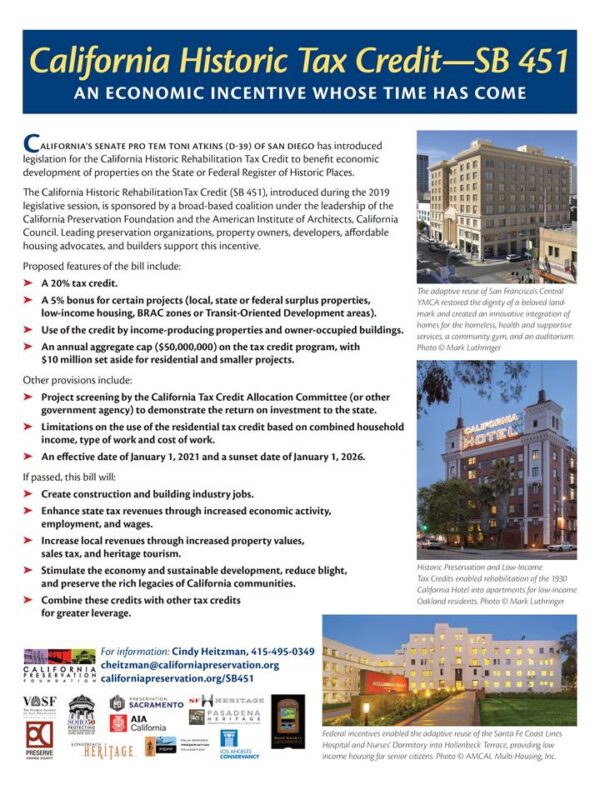
Resolved
CA Historic Rehabilitation Tax Credit
The California historic rehabilitation tax credit (SB 451) was signed into law in October, 2019 to create an important new incentive for economic development through the rehabilitation of historic buildings, many of which can be adaptively reused for much-needed housing. In 2022 the new program will officially go into effect.
Resolved
Issues that may have resulted in imperfect outcomes, but still display significant progress
Issue Details
Development Approval Process
Overview
In October 2019, Governor Gavin Newsom signed Senate Bill 451 into law. This incredibly important bill created a statewide historic rehabilitation tax credit, providing a new financial incentive for the rehabilitation of historic buildings. The program is anticipated to go into effect in 2022.
Earlier in 2019 Senate President pro tempore, Toni G. Atkins introduced SB 451, a bill to create a California historic rehabilitation tax credit. This legislation builds on work done in 2014 with the California Preservation Foundation (CPF) and the American Institute of Architects, California Council (AIACC), to promote tax credits for the rehabilitation of historic buildings. The Conservancy worked to help support this legislation and critical incentive for preservation.
State historic tax credits are a dollar for dollar reduction in tax liability and help make difficult projects financially viable. With these incentives, states not only increase revenue by broadening their tax base, but they also transform areas of disinvestment and put long-vacant or under-utilized buildings back into production. See CPF’s Case Statement on why SB 451 and a California tax credit makes sense.
With California, thirty-seven states now have similar programs.
SB 451 creates a much-needed statewide tool to help incentivize the rehabilitation of historic buildings, many that can be reused to meet critical housing needs. Historic buildings are frequently rehabilitated for housing, and states use tax credits to encourage this reuse. For example, from 2002-16 the Federal Historic Preservation Tax incentive program has made possible 169 projects (totaling $2.8 billion) in California, where a third have improved or helped create new housing. SB 451 will greatly expand this reach.
Below are two examples of Los Angeles-area projects that utilized the Federal Historic Preservation Tax incentive program to ensure financial viability, and could have been further benefited by a California program:
- In 2013 the 1889 Boyle Hotel became a 51 unit affordable housing project with three ground floor commercial tenant spaces. The project created 31 housing units in the historic building and an additional 20 units in the attached new construction. Project completed by East Los Angeles Community Corporation (ELACC).
- In 2003 the 1949 Mobil Oil/General Petroleum Building, later renamed the Pegasus Apartments after the Mobile Oil symbol, was adaptively reused and converted into 322 housing units. Project completed by the Kor Group.
About This Issue
-
Creates a state 20% tax credit for the rehabilitation of historic structures;
-
Creates a 25% tax credit for certain projects (local, state or federal surplus properties, affordable housing, structures in designated census tracts, Base Realignment and Closure Zones and Transit-Oriented Development areas);
-
Allows the use of the credit by income-producing properties and owner-occupied buildings, including single-family residences;
-
Provides a $50,000,000 annual aggregate cap on the tax credit program plus the unused allocation tax credit from the preceding year; and
-
Establishes a review process to ensure that the development projects supported by this tax credit will result in a payback to the State through increased state and local tax collections and jobs.
-
Creates construction and building industry jobs.
-
Enhances state tax revenues through increased economic activity, employment, and wages.
-
Increases local revenues through increased property values, sales tax, and heritage tourism.
-
Stimulates the economy and sustainable development, reduce blight, and preserve the rich legacies of California communities.
-
Combines these credits with other tax credits for greater leverage.
- Makes historic rehabilitation financially feasible
- Attracts private capital to areas that have not seen public investment in decades
- Creates highly paid local jobs
- Consistently provides a strong return on state investment
- Offers a flexible tool for community reinvestment
- Leverages significant private investment
- Benefits a broad range of communities
Our Position
State rehab tax credits allow a property owner to claim a percentage of their rehabilitation expenses against state income taxes and are usually designed to complement the Federal Rehabilitation Tax Credit. These revenue-enhancing programs more than pay for the initial one-time economic cost of the rehabilitation credit. Studies show that a third of the initial cost of a credit is paid back during the construction phase, prior to the issuance of any credit. Missouri reported that one project generated enough in new sales and income taxes to repay the state for the tax credit within the first five years. The California program will include a project analysis to calculate the return on investment to the state.
The California program will be a powerful force for historic places throughout Los Angeles County: revitalizing economically depressed urban areas and local communities adjusting to the phase-out of redevelopment dollars; stimulating public and private investment; and building civic pride as we celebrate our heritage and preserve California’s past.
To keep up-to-date on the latest developments with SB 451 and its eventual roll out, please visit the California Preservation Foundation’s website.
Issue Resources
- SB-451 Personal income and corporation taxes: credits: rehabilitation of certified historic structures.
- State Historic Tax Credits: Maximizing Preservation, Community Revitalization, and Economic Impact, National Trust
- "Editorial: Saving California’s history, sweetened with a tax break," Los Angeles Times, September 4, 2014





